Tony and Dawnelle GuentherJoin us as we explore our beautiful province. Archives
April 2022
|
Back to Blog
Ancient Art8/6/2022 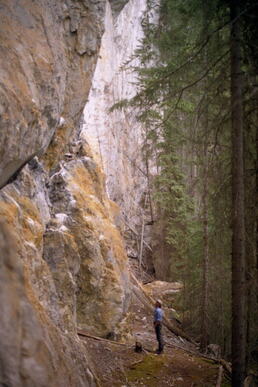 "This doesn't look right." I said to Tony. We had been searching for a while and I was giving up hope that we would ever find what we were looking for. The forest was so thick around us and we saw nothing but lodgepole pines. "Maybe there." Tony said, pointing to a small pullout beside the gravel road. Once we exited the truck we spotted a path that wove into the forest. We followed the trail, past some enormous boulders and over a small hill and then there it was. The limestone cliff was enormous and unexpected, towering far above us. 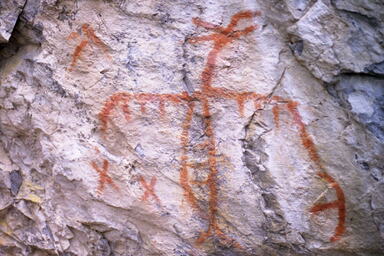 Thunderbird Thunderbird I searched the rock face hoping that this was the place and it didn't take long to confirm that we were in the right spot. After much research we had found what we had been looking for; one of the largest thunderbird pictographs in British Columbia. It took my breath away. 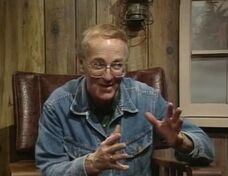 Long before there were GPS units and iphones, we relied on backroad maps to guide us as we explored British Columbia. During one of our earliest trips I noted a small star on a map. Beside the star was the word "pictograph." Hmmm. Tony and I are both artists so the thought of finding ancient works of art was immediately intriguing; but finding them was like finding a needle an haystack. Then, in 1986, CHBC began airing a local television show called "Gold Trails and Ghost Towns." For ten seasons BC historian Bill Barlee regaled host Mike Roberts with fascinating tales of BC's history. He would often tell stories of finding beautiful paintings; giving small clues as where to look. We were hooked. 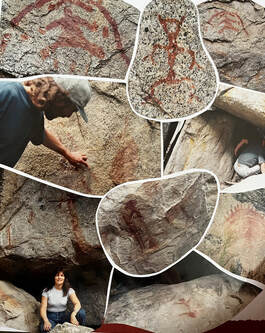 The first pictographs we found were on Old Hedley Road. Before Highway 3 (the Hope-Princeton) was constructed, travellers going between Hedley and Princeton used the wagon road that hugs the north bank of the Similkameen River. Approximately 30 km in length, the Old Hedley Road is often referred to as the "pictograph stretch". Approximately 50 paintings can be found along the road, many visible from your car. You just need to slow down. Some of my favourite paintings can be found in this area including; Deer Corral, Mars and Stepping Stones (Drowned Warrior.) There are hundreds of documented paintings in BC. Some of the earliest research & recordings were done by anthropologist James Teit (1864-1922) and John Corner, who published Pictographs (Indian Rock Paintings) in the Interior of British Columbia in 1968. 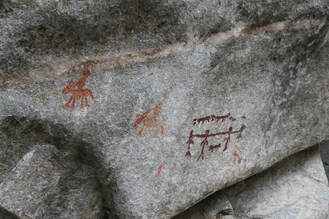 Many articles discuss possible meanings and many theories exist on how they were able to make such durable paint! We are not experts, just two people who love exploring our province. What fascinates us are the untold stories! In his book, Corner tells of a pictograph on the shores of Okanagan Lake depicting a strange creature known by the local people as "Na-ha-ha-itkh" - the water god. Was this an early depiction and evidence of the legendary Ogopogo?! Another set of pictographs (near Hedley) clearly shows 4 men bound together by their necks. The prisoners are surrounded by men (with hats) on horseback and what appears to be four dogs. There are a few theories as to what this collection of paintings could mean but I like Bill Barlee's theory best. Based on oral history, many clues and artifacts, Barlee speculated that a Spanish armada travelled up the Columbia River in approximately 1750. Sometime during their travels they captured some of the local Similkameen people to use as forced labour. Chaining their captives together by the neck and using guard dogs was unfortunately a common practice. After a brutal winter the Similkameen took their revenge. They ambushed the now decimated armada and a massacre took place. According to legend, the Similkameen buried almost all the evidence of the Spaniards -- men, horses and weapons -- somewhere near Olalla. Could these paintings be a clue to the legendary missing Spanish Mound?! After finally finding a site and to see that someone has spray painted over it or attempted to chip it away just breaks my heart. These ancient works of art are part of our living museum and unfortunately there are those who don't give them the respect they deserve. For that reason I am reluctant to give precise locations for the sites that we have found. If you are fortunate enough to find a pictograph site, take a moment to envision the artist. Was he a shaman praying in a cave? A friend mourning the loss of a brother? A traveller marking the way for others? There are so many mysteries surrounding these ancient works of art and we will never know exactly what they mean. What is important is that all pictograph sites are an integral and precious piece of British Columbia's amazing, beautiful and yes, sometimes sorrowful history. OUR PICTOGRAPH GALLERY - All the pictograph photos in this blog are our own. Please do not use without permission.
0 Comments
Read More
Leave a Reply. |
 RSS Feed
RSS Feed
